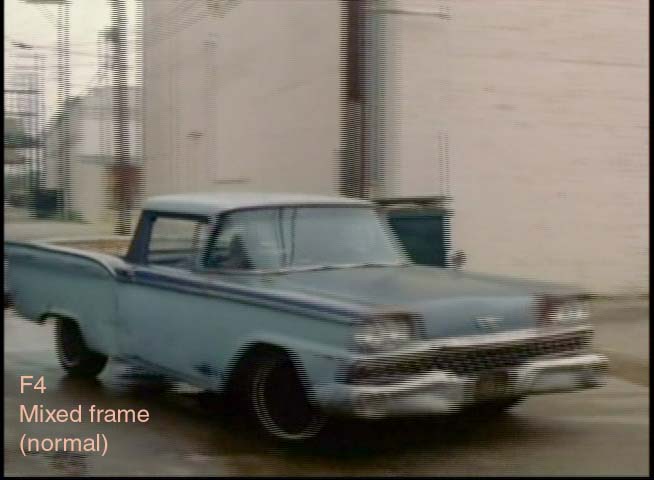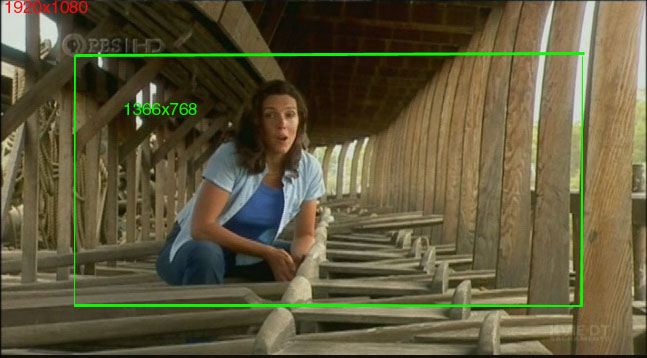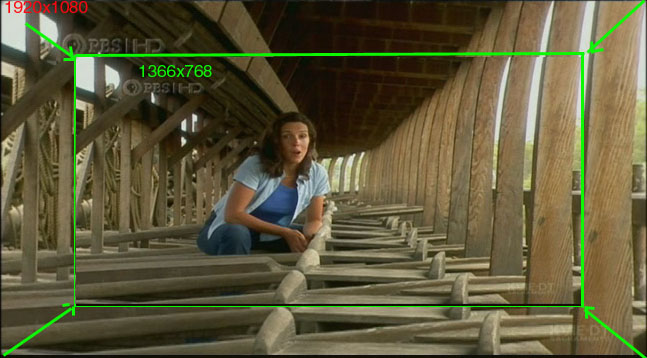I just bought a Philips plasma and I dont see a difference with dvds between my standard Sony dvd player via HDMI and my Toshiba HD-dvd player via HDMI. Can anyone explain why because I'm about to return the Toshiba?
Add To Archive
+ Reply to Thread
Results 1 to 29 of 29
-
-
What resolution are you sending over HDMI?
Which Philips Plasma? Many are only 1024x768 native resolution.Recommends: Kiva.org - Loans that change lives.
http://www.kiva.org/about -
The resolution is @ 1080I. My plasma accepts 1080I with a native resolution of 1366 X 768
-
If both are doing a upconversion to 1080i you wont notice any big difference. Buy a hddvd movie and compare instead....if you still can't see any difference get new glasses.

-
I agree with Baldrick. Would you mind explaining why you think there would be a difference? Perhaps you have a mistaken understanding of what each player is supposed to do. Both players should upconvert to 1080i and you shouldn't expect much, if any, difference for standard DVD upconversion. Do note that your TV is incapable of displaying 1080i/p, so it is downconverting whatever signal it gets. I believe it will downconvert to 1366x768, but edDV can probably confirm that.
-
You're not getting 1080i displayed from either device. The dvd player is upconverting the 480p dvd to 1080i and then your tv is downconverting it to 720p and then displaying at roughly 768p (not a 'real' resolution). The hd-dvd player is sending a 1080p signal and converting it to 1080i and then the TV is playing its game and downconverting it to 720p and then to 768p. (Some tv/monitors are different, and may be skipping the 720 to 768 conversion). The dvd player may simply be a good upconverter and why you're seeing such a good dvd picture. I get the same on my Xbox360 when playing dvds to my 1080p televsion.
I'm not really suprised you don't see (much of?) a difference. Though there's a big difference between a 480p (dvd) picture and a 1080p/i (hd-dvd) picture, you're (probably) not going to see (a significant) difference with your setup. Instead of 4x the resolution, you're only getting 2x the resolution.
If you really want to see a difference, get a 1080p tv/monitor. Huge difference.Have a good one,
neomaine
NEW! VideoHelp.com F@H team 166011!
http://fah-web.stanford.edu/cgi-bin/main.py?qtype=teampage&teamnum=166011
Folding@Home FAQ and download: http://folding.stanford.edu/ -
Thanx for the replies but when I verify the signal on my plasma, it reads @ 1080I. I called Philips and they said if I use a HDMI cable from a standard DVD, I will truly get a 1080I signal. The reason why I didnt buy a plasma @ 1080P is because of being more expensive and many sales people advised me that there really isnt a difference between 1080I and 1080P. Some HD dvds play better but not all compare to my Toshiba and standard Sony dvd.
-
#1-Sure, you're verifying that the incoming signal reads 1080i. That's exactly what both DVD players would give you (since your Sony is most likely upconverting, and the Toshiba is interlacing 1080p to 1080i since you don't have a 1080p monitor). That isn't really in question. It's what happens before and what happens after.
Before: Upconversion (480p -> 1080i) vs. Cross-conversion/Interlacing (1080p -> 1080i) should be some difference----UNLESS your source is Std. DVD in both cases. Then the Toshiba is ALSO doing upconversion too.
After: Downconversion happens either way (either 1080i to 720p and then to 768, or 1080i to 768 direct). Either way, you're resizing NOT on 2:1 or 3:2 or anything simple. These are both INTERNAL to the monitor, where your "signal verification" has no meaning because EVERYTHING that isn't 1366x768 will need to be scaled to that resolution. Only a WXGA signal will be 1:1 with no scaling. That would probably only arrive via a VGA or DVI port (possible but not likely with HDMI as it's so "CE-standards-oriented").
You've never clearly said yet--are you even comparing DVD playback vs. HD-DVD playback? If not, why would you even expect to see anything different at all? The whole point of a HiDef player (as opposed to an upconverting player) is to get true HD quality from start to finish, no faking/upscaling.
There IS a difference between 1080p60 and 1080i60. There's a small difference between 1080p24 and 1080i60, mainly having to do with the need (or not) for pulldown depending upon your choice of monitor. But the difference is still there.
BTW, here's a tip: Unless they've already proven themselves time and again of having GREAT AND OBJECTIVE technical knowledge, NEVER go by what a salesman thinks about technical quality!
Scott -
OooPs I assumed he was using a HD DVD for comparison. Why else buy a HD DVD player?Originally Posted by Baldrick
-
The picture clarity is great. With HD DVD, you'll see nose hairs, folds in clothing and other details that weren't visible with standard DVDs.
On the HD DVD version of "Training Day," Denzel Washington's police cruiser gleams. On "Million Dollar Baby," the sweat on Hilary Swank's forehead glistens.
Here's how it's done: Single-layer high definition DVDs can hold 15 gigabytes of data, compared with the 4.7 gigabytes on a standard single-layer DVD. That's enough to support the resolution of today's high-definition televisions. -
The bulk of movies today are on dual layer dvd.The movie itself varies from 5-7 gb. depending on length and mb/sec the dvd was produced in.Still a far cry from the available data on a hd-dvd.
There are still movies on single layer,but they tend to be shorter or animated.bmiller,ont.canada -
Toneystone,
Just because you are inputing a 1080i signal, does not mean you are getting a 1080 picture. Your tv has a native resolution off 768p. That's the most you'll get. Review previous posts on what the conversions are to get the signals to your tv.
I also mis-read your initial post as edDV did and thought you were comparing an hd-dvd and a dvd. You were comparing the same dvd. In that case, you SHOULDN'T be seeing any difference. The only thing you would be comparing is the upscaling feature of the hd-dvd drive and the dvd player. In this case, they're upsaling a 480p signal to 1080i and then it gets downscaled to 720p and then to 768p to match your tv.
If you really want to see a difference and make a valid comparison, go to the store and have the sales person put in a dvd and an hd-dvd version of the same movie. Something like King-Kong or MI:III should do the trick. Have them display it on a 720p/768p tv/monitor and you'll see a difference. Then, have them put the same signals to a 1080p tv/monitor and you'll REALLY see the difference.
Disclamer: This of course assumes that the all else is equal - connections/wires, display tuning, lighting, effective distance from the tv....Have a good one,
neomaine
NEW! VideoHelp.com F@H team 166011!
http://fah-web.stanford.edu/cgi-bin/main.py?qtype=teampage&teamnum=166011
Folding@Home FAQ and download: http://folding.stanford.edu/ -
I called Philips and they told me my TV can accept a signal of 1080I via HDMI and any source of 1080I will display that resolution on my TV. Who do I believe?
-
If the native resolution is 1366x768 then that is all it can display. It may (and does) accept multiple types of input, but it can display only one.
If the signal is higher in resolution (1080), the TV will downscale to 768. If it is lower (480, 720) then it will upscale to 768. No two if, ands, or buts about it. Your display can only display one resolution though it accepts many.Have a good one,
neomaine
NEW! VideoHelp.com F@H team 166011!
http://fah-web.stanford.edu/cgi-bin/main.py?qtype=teampage&teamnum=166011
Folding@Home FAQ and download: http://folding.stanford.edu/ -
What is your TV Model Number?Originally Posted by toneystone
-
A plazma can't display interlace. It can only display progressive at the native 1366x768 resolution. Everything else needs conversion to 1366x768 progressive. 1080i and 480i need deinterlace. Deinterlace can be done well (e.g. cinema inverse telecine) or poorly.Originally Posted by toneystone
-
That TV does have inverse telecine for 1080i and 480i sources "3:2 Pulldown Compensation".Originally Posted by toneystone
Still it was engineered for 720p HD source. Try 1080i and 720p from the Toshiba HD-dvd player* and watch for motion artifacts for 1080i. If the inverse telecine is adequate then evaluate 1080i vs. 720p for sharpness at 1366x768. I would expect little difference.
*use an HD DVD not a standard DVD. For standard DVD, compare 480p to 720p. -
There's a difference in terminology and association here:Originally Posted by toneystone
Phillips guys are speaking in generalities. Yes your 1080i signal will be "accepted" (we never disputed that). Yes it will still display this "in HiDef" (we never disputed that either). However, NO it won't be exactly "THAT RESOLUTION".
The rest of what we've told you already, you should believe. If you want to get back to the Philips guys and say "These guys told me that the monitor internally downscales and deinterlaces to 1366x768" and I'm sure that when pushed to be explicit, they'd agree with us.
Think about this:
If this monitor DIDN'T internally downscale AND deinterlace, then when given a 1080i signal, it would show either a signal with BLACK on every other line, or CROPPED to the central 1366x768 window, or BOTH. It's like trying to fit a square peg in a round hole--something's got to give.
Scott -
Are motion artifacts in fast moving subjects caused by the tv downscaling 1080i to 720p or from the source signal.Some if not all sources don't use the 19 mb/sec. of a hidef signal and usually transmit in the 10-12 mb/sec area.I have a Toshiba dlp 720p set and notice these fast motion artifacts in sports only,everything else is ok.My satellite receiver is set to native,and i believe most hidef transmissions are 1080i.I think ABC is the exception and use 720p.
bmiller,ont.canada -
Several issues here.Originally Posted by bmiller
Sports at 720p (ABC, FOX, ESPN native) results in crisp progressive streams even through fast motion.
Above I think we were talking about 24 fps movies. 1280x720p converts 24fps to 59.94fps by repeating frames in a 3 then two sequence.
1080i/29.97 like 480i/29.97 requires the telecine field sequence described here
http://www.dvdfile.com/news/special_report/production_a_z/3_2_pulldown.htm
Two of the five frame sequence looks like this with odd and even fields referencing different film frames.

If the HDTV inverse telecines to 24p and then frame repeats to 59.94 there is no difference between 1080i and 1080p for film source.
If instead the HDTV blend deinterlaces these frames, the result will be a two blurry frames out of five. -
If they are correct, the picture would look like the inner green rectangle. Sure a 1366x768 progressive display can display a cropped window of the 1920x1080 source at full resolution. Most 1366x768 HDTV sets will downscale 1920x1080 to 1366x768 so you can see the whole picture. I guess Philips has a different idea. Their idea works until someone stands up.Originally Posted by toneystone

-
Alright it's a wrap. Thanx guys. I guess I spent $2K for a plasma that doesnt really display 1080I. At least it plays very well and HD signals look like real HD. But hey freaking technology is a mother...cant keep up with it!
-
I'm not trying to be insulting or critical, but I hope you learned a valuable lesson from this. I bought a Samsung HD TV last December and before I bought it, I did a lot of research. I read reviews online. I made sure I understood the technology. I knew exactly what I was getting and that the TV I bought really had 1080p resolution and wasn't just "compatible with 1080p". "Compatible" is a trick word that HD TV manufacturers use and all it means is that the TV can do something with that type of signal, not that it can actually display that signal as is. We see posts here from time to time from other guys who find out that their TV doesn't really display 1080i or 1080p at all like they thought, but has a resolution similar to yours. Remember too that salespeople will either deliberately lie to get the sale or just tell you something wrong that they may think is correct. Before spending this kind of money, you need to know exactly what you are getting and if you don't have time to do the research to understand what you are getting, this is what can happen. You could always have posted here and asked "Will this TV really display 1080i?" and someone could have told you that it won't. Again, I do not want to insult you, but I suggest that in the future before you spend this kind of money that you be sure you know what you are getting or ask in a forum like this where people who do understand the technology can help you.Originally Posted by toneystone
-
Ok this is what I just found out. The best thing for me to do is select 1080I on my Toshiba HD dvd because Philips sworn it will display 1080I on my plasma but If I select 1080P on the Toshiba, it will downconvert to 768P. If I can at least display 1080I that's fine with me for now until I'm able to get TV with 1080P.
-
FWI: Which setting you actually use is irrelevant. You should experiment with all of the settings and use whichever one displays the best. Just because 1080i is the highest setting and your TV supports 1080i (although with the restrictions mentioned above numerous times) doesn't mean 1080i will provide the best picture. The setting may also vary on the type of video you are watching (ie: sports or movies).
Google is your Friend -
I'm sorry but you still aren't getting it. Your display is 768p (1366x768p). You want it to display 768p.Originally Posted by toneystone
If you set the Toshiba to 1920x1080i, the Toshiba will telecine the native 1920x1080p/24 to 1920x1080i/29.97 or in other words interlace it. Then your HDTV needs to attempt an inverse telecine to get back to 1920x1080p/24. If it is successful you get back where you started. Then the HDTV will DOWNSCALE to the display resolution of your plasma which is 1366x768p.
If you feed 1920x1080p from the Toshiba to the HDTV, the HDTV just needs to do the downscale for display. It's a more direct path and less prone to error.
Why would you want your plasma to display at a resolution other than the dots on the screen? See the picture above. You would only see part of the picture. -
What you want is the picture to be resized so that is all fits on your display. Your display is represented by the inner rectangle.

Similar Threads
-
Can you copy multiple mini-DVD discs to one standard DVD?
By darkcyber in forum Camcorders (DV/HDV/AVCHD/HD)Replies: 3Last Post: 2nd Jan 2011, 10:44 -
Standard DVD in HD
By killerener99 in forum Newbie / General discussionsReplies: 15Last Post: 16th Apr 2009, 06:14 -
burn RMVB file to DVD to play on standard DVD player
By samoyed in forum Newbie / General discussionsReplies: 8Last Post: 14th Mar 2009, 22:29 -
Converting .VRO file onto a DVD disc (to play on standard DVD players) ?
By superman123x in forum Video ConversionReplies: 21Last Post: 24th Mar 2008, 18:40 -
multiple .avi files on a DVD-R that is viewable on a standard DVD player
By ottawadave in forum Video ConversionReplies: 8Last Post: 18th Jul 2007, 12:32




 Quote
Quote